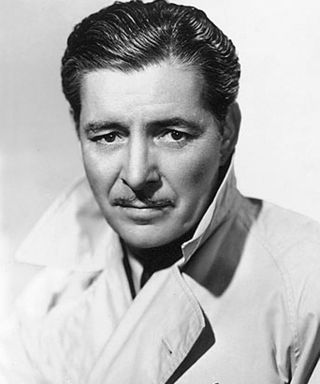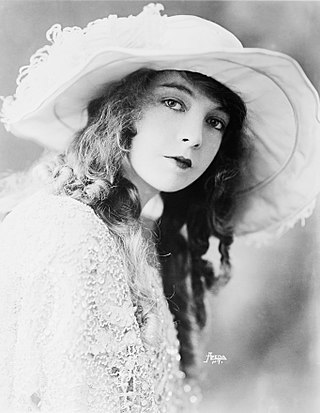
Broken Blossoms or The Yellow Man and the Girl, often referred to simply as Broken Blossoms, is a 1919 American silent drama film directed by D. W. Griffith. It was distributed by United Artists and premiered on May 13, 1919. It stars Lillian Gish, Richard Barthelmess, and Donald Crisp, and tells the story of young girl, Lucy Burrows, who is abused by her alcoholic prizefighting father, Battling Burrows, and meets Cheng Huan, a kind-hearted Chinese man who falls in love with her. It was the first film distributed by United Artists. It is based on Thomas Burke's short story "The Chink and the Child" from the 1916 collection Limehouse Nights. In 1996, Broken Blossoms was included in the annual selection of 25 motion pictures to be added to the National Film Registry of the Library of Congress.

Ronald Charles Colman was an English-born actor, starting his career in theatre and silent film in his native country, then emigrating to the United States and having a highly successful Hollywood film career. He starred in silent films and successfully transitioned to sound, aided by a distinctive, pleasing voice. He was most popular during the 1920s, 1930s and 1940s. He received Oscar nominations for Bulldog Drummond (1929), Condemned (1929) and Random Harvest (1942). Colman starred in several classic films, including A Tale of Two Cities (1935), Lost Horizon (1937) and The Prisoner of Zenda (1937). He also played the starring role in the Technicolor classic Kismet (1944), with Marlene Dietrich, which was nominated for four Academy Awards. In 1947, he won an Academy Award for Best Actor and Golden Globe Award for Best Actor for the film A Double Life.

Lillian Diana Gish was an American actress. Her film-acting career spanned 75 years, from 1912, in silent film shorts, to 1987. Gish was called the "First Lady of American Cinema", and is credited with pioneering fundamental film performance techniques. In 1999, the American Film Institute ranked Gish as the 17th greatest female movie star of Classic Hollywood cinema.

Dorothy Elizabeth Gish was an American stage and screen actress. Dorothy and her older sister Lillian Gish were major movie stars of the silent era. Dorothy also had great success on the stage, and was inducted into the American Theater Hall of Fame. Dorothy Gish was noted as a fine comedian, and many of her films were comedies.

James Edward Abbe was an American photographer.

Romola (1862–63) is a historical novel written by English author Mary Ann Evans under the pen name of George Eliot set in the fifteenth century. It is "a deep study of life in the city of Florence from an intellectual, artistic, religious, and social point of view". The story takes place amidst actual historical events during the Italian Renaissance, and includes in its plot several notable figures from Florentine history.

Way Down East is a 1920 American silent romantic drama film directed by D. W. Griffith and starring Lillian Gish. It is one of four film adaptations of the melodramatic 19th century play of the same name by Lottie Blair Parker. There were two earlier silent versions and one sound version in 1935 starring Henry Fonda. Griffith's version is particularly remembered for its climax in which Gish's character is rescued from doom on an icy river.

Gold and Glitter is a 1912 American silent drama film co-directed by D. W. Griffith and Frank Powell. Lillian Gish, in the leading female role, was praised for its variety of emotion, in comparison to her previous roles.
La Bohème is a 1926 American silent drama film directed by King Vidor, based on the 1896 opera La bohème by Giacomo Puccini. Lillian Gish and John Gilbert star in a tragic romance in which a tubercular seamstress sacrifices her life so that her lover, a bohemian playwright, might pen his masterpiece. Gish, at the height of her influence with Metro-Goldwyn-Mayer studios, asserted significant control over the production, determining the story, director, cast, cinematography, and costume design. In February 2020, the film was shown at the 70th Berlin International Film Festival, as part of a retrospective dedicated to King Vidor's career.
The Lily and the Rose; sometimes Lily of the Rose is a 1915 American silent drama film directed by Paul Powell and starring Lillian Gish. Preserved at the Library of Congress. Composer J. A. Raynes composed theatre organ music to accompany this film.

The Great Love is a 1918 American silent war drama film directed and written by D. W. Griffith who, along with scenario writer Stanner E.V. Taylor, is credited as "Captain Victor Marier". The film stars George Fawcett and Lillian Gish. Set during World War I, exterior scenes were shot on location in England. The Great Love is now considered to be a lost film.

True Heart Susie is a 1919 American drama film directed by D. W. Griffith and starring Lillian Gish. A print of the film survives in the film archive of the British Film Institute. The film has seen several VHS releases as well as a DVD issue.
The White Sister is a 1909 play by Francis Marion Crawford and Walter C. Hackett.

The White Sister is a 1923 American silent drama film starring Lillian Gish and Ronald Colman, directed by Henry King, and belatedly released by Metro Pictures. It was based on the 1909 play of the same name by Francis Marion Crawford and Walter C. Hackett. It is the second of four adaptations of the play, preceded by a 1915 production and followed by a 1933 sound film, starring Helen Hayes and Clark Gable, and a 1960 Mexican production.

The Scarlet Letter is a 1926 American silent drama film based on the 1850 novel of the same name by Nathaniel Hawthorne and directed by Swedish filmmaker Victor Sjöström. Prints of the film survive in the MGM/United Artists film archives and the UCLA Film and Television Archive. The film is now considered the best film adaptation of Hawthorne's novel.

Ronald Colman began his career as an actor on the stage following his service in the British Army during World War I. He made his film debut in an unreleased two-reeler titled The Live Wire (1917). After achieving minor success on the stage and in British films, he immigrated to the United States in 1920. There he continued his acting with only moderate success until he was offered the lead opposite Lillian Gish in The White Sister (1923). The film's popularity and critical acclaim led to Colman becoming a major star and also a romantic idol of the silent cinema. As a contract player for Samuel Goldwyn, Colman was cast as leading man to many of the top actress as the silent era. In five of his silents he formed a romantic team with Hungarian actress Vilma Bánky.

Clarine E. Seymour was an American silent film actress.

The White Rose is a 1923 American silent drama film directed by D. W. Griffith. The film was written, produced, and directed by Griffith, and stars Mae Marsh, Ivor Novello, Carol Dempster, and Neil Hamilton. Though this film is extant, it is one of Griffith's rarely seen films.
The George Eastman Award for distinguished contribution to the art of film was established by the George Eastman Museum in 1955 as the first film award given by an American archive and museum to honor artistic work of enduring value.

Betty Jewel was an American actress active in the 1920s.
















